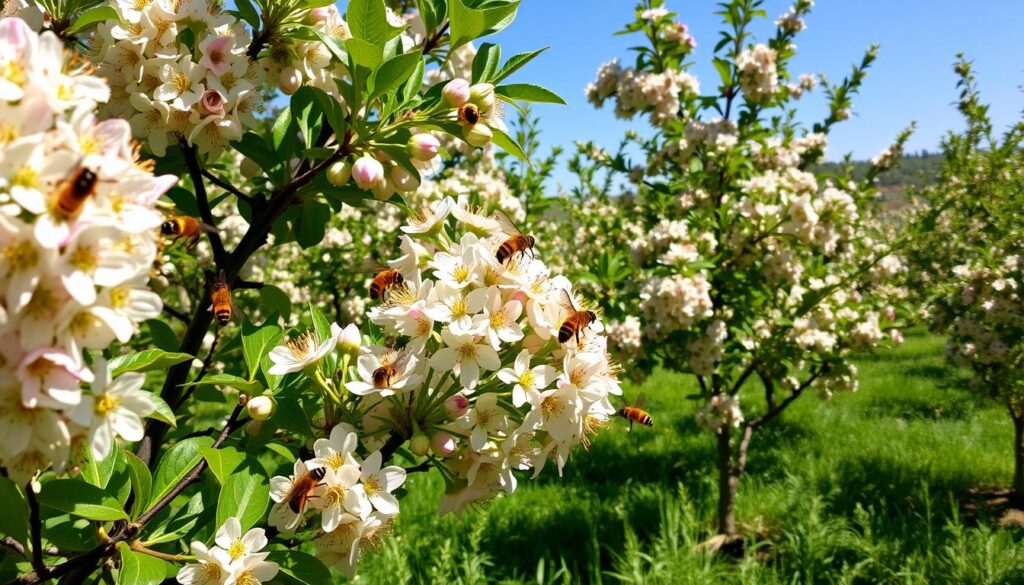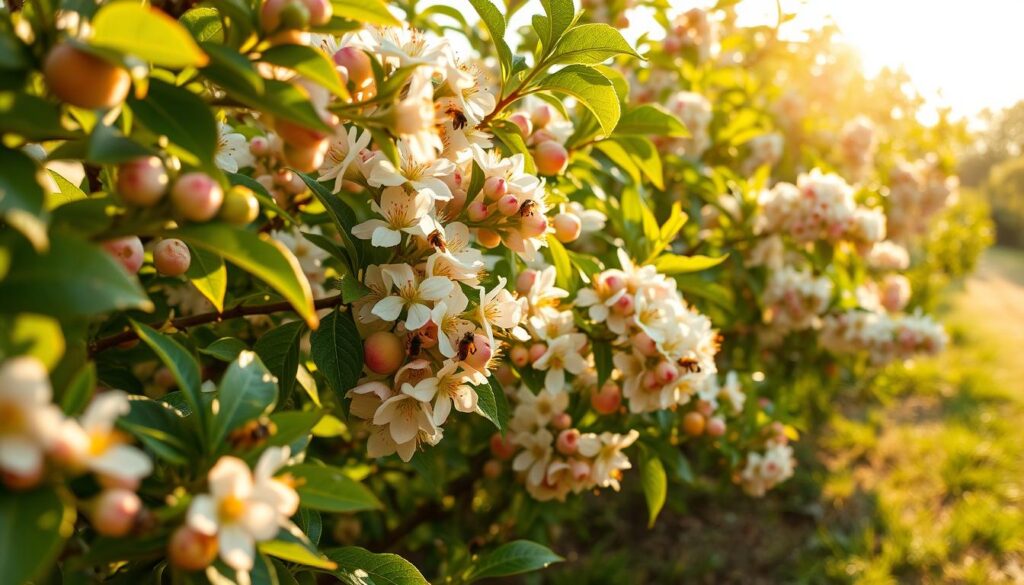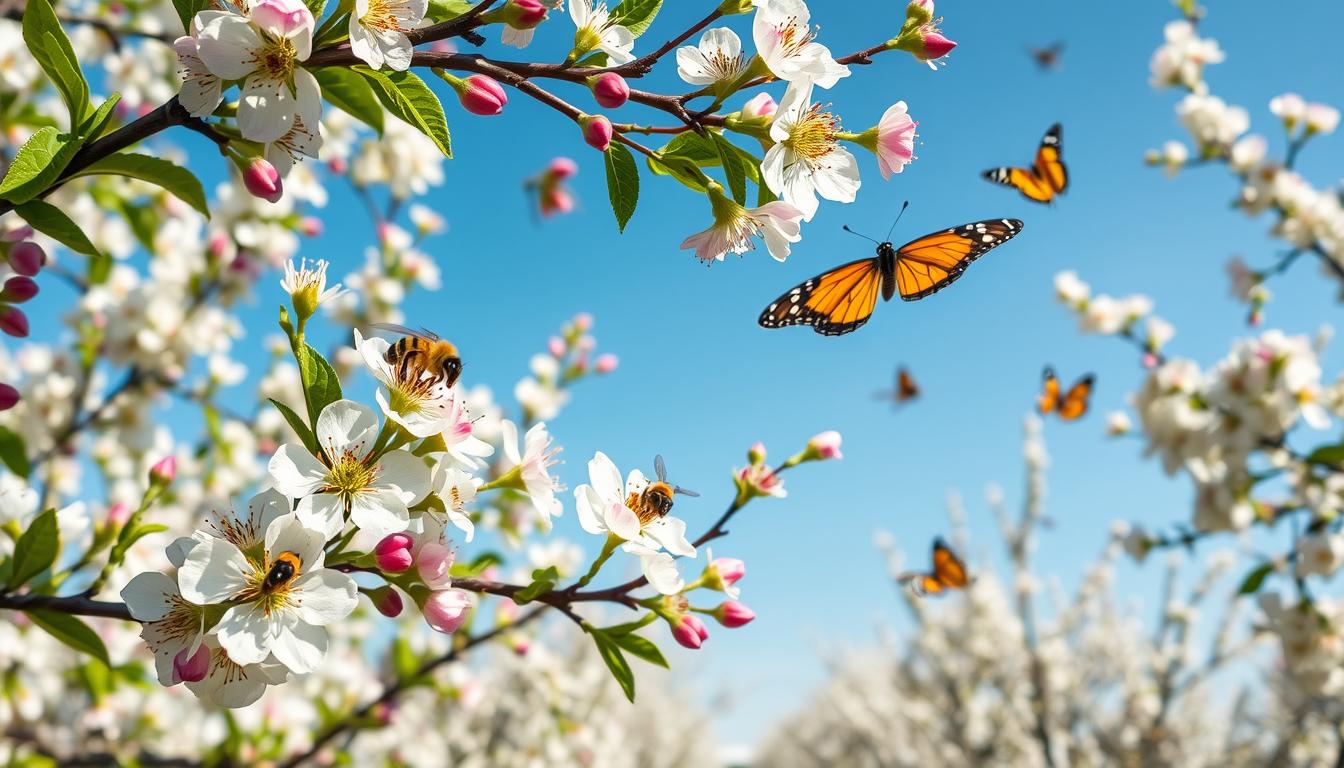Learning effective fruit tree pollination techniques is key for the best fruit yields, especially in big orchards. Pollination is crucial for fruit production, affecting both quality and quantity. I’ll show how different methods can help your garden grow better and last longer. By understanding the best pollination techniques for fruit trees, I want to help both new and experienced gardeners get a great harvest.
Using the right fruit tree pollination strategies can lead to a great harvest season. For instance, tart cherries need at least 80% of flowers to bloom for good yields. Apple trees also do well with crabapple pollinizers nearby. Knowing these methods not only increases yields but also makes gardening more enjoyable.
I suggest checking out GardenBeginner.com for more gardening tips and support. Let’s discover how important pollination is for a successful fruit garden together.
Key Takeaways
- Effective fruit tree pollination is critical for optimizing yields.
- Strategies like interplanting with pollinizer varieties enhance fruit production.
- Understanding individual fruit tree requirements is key to successful gardening.
- Utilizing both managed and wild bees can significantly boost pollination rates.
- Creating a pollinator-friendly environment supports diverse species and improved yields.
The Importance of Pollination in Fruit Production
Effective fruit tree pollination is key for healthy orchards and sustainable farming. It helps move pollen between flowers, which is crucial for fertilization and fruit growth. Each fruit type needs its own pollination method, shaping how we pollinate trees. Knowing these needs helps us improve pollination strategies and increase yields.
Understanding Pollination’s Role in Fruit Development
Pollination is vital for fruit growth. A single bee hive can visit up to 5,000 flowers a day. This shows how efficient bees are.
For example, apple orchards need careful pollination. One hive is enough for medium-strength colonies on semidwarf trees. Healthy pollinators lead to better fruit set and quality.
Impact of Pollination on Fruit Quality and Yield
Good pollination means better fruit quality and size. Research shows it improves fruit shape and sweetness, which are key for the market. Sweet cherries need at least 80% pollination to be profitable.
Cross-pollination also boosts genetic diversity. It helps avoid inbreeding risks in fruits like Japanese plums and European varieties.
Besides bees, bats and insects are important pollinators. They help over 150 crops in the U.S. Understanding pollination helps us improve horticulture and support the ecosystem. For more info, check out Purdue Extension’s pollination guide for fruit trees.
Types of Pollination Techniques
Knowing the different fruit tree pollination methods is key to better fruit yields and quality. The pollination method chosen can greatly impact the success of fruit trees. I’ll look at self-pollination and cross-pollination, and manual methods for different situations.
Self-Pollination vs. Cross-Pollination
Self-pollination happens when pollen from the same flower fertilizes its ovules. This works well for some fruits like peaches and apricots. On the other hand, cross-pollination needs pollen from another flower, often from different trees. Most apple trees need cross-pollination to bear fruit.
Planting compatible varieties together helps with effective fruit tree pollination.
The following table shows how different fruit trees pollinate:
| Fruit Tree | Self-Pollination | Cross-Pollination Requirement | Pollinator Preference |
|---|---|---|---|
| Apple | No | Yes | Bees |
| Pear | Partially | Yes | Osmia cornuta |
| Almond | No | Yes | Honeybees |
| Japanese Plum | Yes | No | Bees |
| European Plum | Yes | Mixed | Bees |
Manual Pollination Methods
Manual pollination is useful when natural pollinators are few, like in isolated orchards or bad weather. Using a small brush or cotton swab to move pollen between flowers helps. This ensures fruit tree pollination methods work even when it’s hard.
This method keeps fruit production up in places where pollinators don’t visit enough. Knowing when to pollinate is important for success.
Pollinator Diversity and Its Importance
Learning about the different pollinators helps us see how vital they are to farming. Pollinator diversity is key for a healthy ecosystem. It’s also important for getting fruit trees to pollinate well. Bees, like honey bees and wild ones, are very important for many crops. They help move pollen, which affects how much and how well the fruit grows.
The Role of Bees in Fruit Tree Pollination
Bees are some of the best pollinators, helping us eat one out of every three foods. They collect and spread pollen, which is crucial for fruit growth. For example, apples need bees to cross-pollinate because they can’t pollinate themselves. This makes the apples taste better and grow bigger.
Other Pollinators: Hoverflies, Moths, and Wasps
Bees get a lot of attention, but hoverflies, moths, and wasps are also important. They help flowers become fertile, adding to the variety of pollinators. Using these different pollinators in farming can make crops better and more resilient. It shows how important it is to protect their habitats and keep biodiversity high.

The Best Pollination Techniques for Fruit Trees
Knowing the difference between managed and wild pollinators can really help with fruit tree pollination. Managed pollinators, like honey bees, are reliable and visit often when flowers are out. On the other hand, wild pollinators like bumblebees and solitary bees add to the garden’s diversity. Each type has its own benefits, depending on what my garden needs.
Using Managed Pollinators Versus Wild Pollinators
Honey bees are the top choice for pollinating fruit trees. They do best when it’s about 65°F. Bumblebees and solitary bees, however, like it a bit cooler. It’s important to pollinate within 2 to 4 days after flowers bloom for the best results.
Adding floral strips or planting a variety of flowers can attract more pollinators. This helps fruit trees grow bigger and taste better.
Optimizing Pollinator Visits with Planting Strategies
Planting in a smart way can get pollinators to visit more often. For example, planting ornamental crabapple trees with apples and sweet cherries can help with cross-pollination. This leads to bigger, better-tasting fruits.
Using self-fertile varieties alongside those that need a partner can also boost pollination. Apples and pears, for instance, need different types to pollinate well. This makes my garden a better place for pollinators.
Optimal Pollination Methods for Different Fruit Trees
Knowing what each fruit tree needs for pollination is key to getting more fruit and better quality. Different trees have their own ways of needing pollination. This means I have to tailor my orchard care to each type, focusing on both self-pollination and cross-pollination benefits.
Apple and Pear Pollination Requirements
For apples, picking the right types is crucial because many can’t pollinate themselves. Planting specific pollinizer trees like Malus floribunda helps a lot. The goal is to have one pollinizer for every sixteen trees, with 50-100 feet between them for best results.
Pear trees also need careful planning. I plant one pollinator for every eight pear trees, which is about 10-12% of the total. Choosing the right varieties is key to better yields and quality.
Strategies for Stone Fruits: Cherries and Peaches
Stone fruits like peaches and cherries mostly pollinate themselves but cross-pollination helps a lot. Pairing trees of the same variety boosts fruit set. Cherries need at least 80% of flowers pollinated to produce good fruit, making pollination strategies very important.
Using plants that attract bees and reducing pesticides helps pollinators. Studies show that using Japanese Orchard Bees can pollinate better than honeybees. This is vital for better fruit quality and yield.
| Fruit Type | Pollination Type | Recommended Pollinator Ratio | Essential Spacing |
|---|---|---|---|
| Apple | Cross-pollination | 1:16 | 50-100 feet |
| Pear | Cross-pollination | 1:8 | 50-100 feet |
| Peach | Self-fruitful | N/A | 30-50 feet |
| Cherry | Self-fruitful with benefits of cross-pollination | Varies with variety | 20-50 feet |
By using these specific pollination strategies, I can greatly improve fruit quality and quantity. For more tips and resources, check out the affiliate disclaimer to support my work.
Impact of Environmental Factors on Pollination
Environmental factors greatly affect how fruits are pollinated. Weather changes, like temperature and rainfall, can change when flowers bloom. This can make pollination harder or easier.
It’s key to know how these changes impact flowers and pollinators. This knowledge helps increase fruit production.
Weather Conditions and Blossom Timing
Weather decides when flowers bloom and how active pollinators are. A study found that birds in the Southwest Australian Floristic Region do well in certain weather. But, less rain over 25 years is a problem for plants that rely on these birds.
Also, how bright it is affects bees, which are crucial for pollination. This shows why we must adapt to changing weather.
Creating Pollinator-Friendly Habitats
Creating spaces that help pollinators is very important. Good landscape management is key. Keeping native plants helps pollinators a lot.
By having many plant types and nesting materials, we help bees and birds. This not only helps these important species but also boosts pollination during key times.

Monitoring Pollination Success
Monitoring pollination success is key to boosting fruit yield. It helps us understand how well pollination happens. This knowledge guides us in improving crop yields. Today, we have many new ways to track pollination, giving us important insights into how pollinators work.
Technologies for Tracking Insect Movements
Modern tech is changing how we watch pollination in orchards. AI systems help track insects, giving us accurate visit rates. Video analysis lets us see pollinators up close, helping us grasp how they pollinate flowers.
This tech also lets us count different pollinators. Knowing which ones are best helps us plan better. It’s crucial for improving fruit set and yield.
Understanding Pollination Levels and Crop Yields
Now, we can link pollination success to crop yields more clearly. I use advanced tracking tech to see how pollinators affect fruit. This info helps me make better choices about pests, environment, and crop types.
| Tracking Method | Description | Effect on Pollination Success |
|---|---|---|
| Video Analysis | Utilizes cameras to monitor insect activity around flowers | Provides real-time data on visitation and behavior |
| Remote Sensing | Employs satellite imagery to assess flowering patterns | Identifies ideal blooming times for maximum pollinator attraction |
| Citizen Science Programs | Engages the public to report pollinator sightings and behavior | Increases data collection efforts and aids in understanding local populations |
Using these technologies, we get a better view of pollination success. This leads to new ways to farm, boosting fruit production.
Common Challenges in Fruit Tree Pollination
Fruit tree pollination faces many obstacles that can reduce fruit yields and quality. The decline in pollinator numbers and pests harming them are key issues. Understanding these challenges helps in improving fruit harvests.
Under-Pollination and Its Effects on Yields
When not enough pollinators are around, fruit trees don’t get enough pollen. Honey bees can visit up to 5,000 flowers a day. But, weather and other factors can limit their work.
- Bad weather like rain or wind stops bees from flying, hurting pollination.
- Many fruit trees need help from other trees to pollinate well, like pear trees.
The short time when flowers are open is critical. Commercial orchards need the right number of bees to pollinate. Apple trees, for example, need one or two hives per acre.
Managing Pest Populations and Pollinator Health
Keeping pollinators safe is linked to controlling pests. Pesticides harm bees and the ecosystem. We should use fewer pesticides and adopt better pest management.
Having enough pollinators is key for good pollination and fruit. Crops like blueberries need different bees to pollinate. Supporting many pollinators helps my orchard grow more fruit.
For more tips on pollination, visit my contact page. Knowing these challenges helps us grow more fruit and care for our orchards better.
| Fruit Type | Pollination Requirement | Notes |
|---|---|---|
| Apple | Needs a pollinator nearby | Some varieties are partially self-fertile |
| Pear | Requires cross-pollination | Mostly self-sterile, limited to a few self-fertile types |
| Blueberry | Cross-pollination required | Optimal fruit set when varieties bloom simultaneously |
| Peach | Usually self-fertile | Some benefit from cross-pollination |
| Cherry | May require cross-pollination | Some varieties serve as universal pollinators |
Conclusion
In this article, we’ve seen how important pollination is for fruit trees. It helps them grow more and better fruit. There are many ways to pollinate, from nature to machines, and using different helpers.
Every fruit tree is different, and so are the challenges they face. Things like weather and pests can hurt their growth. But, with the right methods, we can overcome these problems.
By using new ways to pollinate and better tools, farmers can face these challenges head-on. Without good pollination, growing fruit could get much harder. So, it’s crucial to take care of our environment and use green practices.
As we move forward, learning and changing our farming ways will be key. Using new pollination methods not only helps us grow more fruit. It also makes our farms stronger and more able to handle challenges.
For more info on getting help and resources, check out this link: funding information for growers.



Leave a Reply